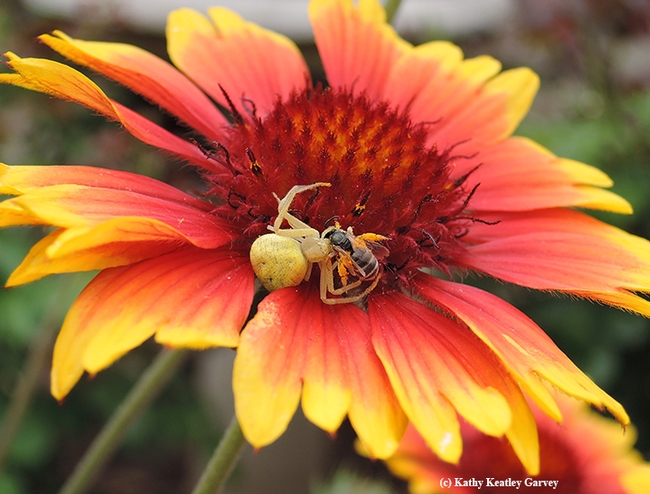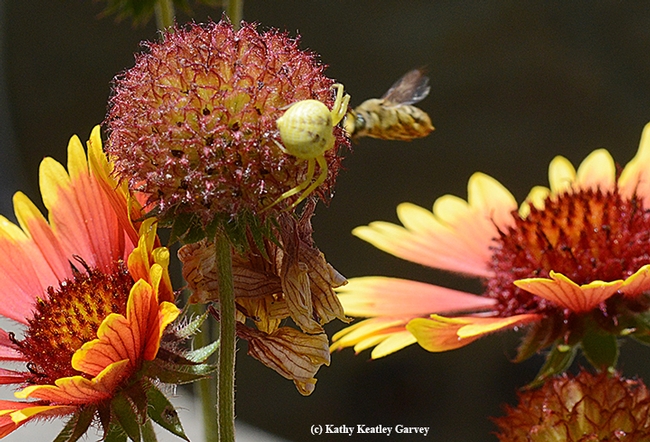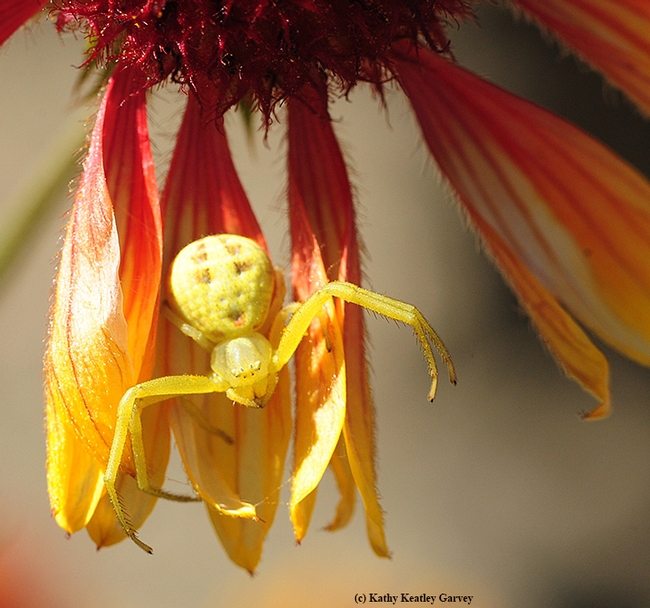- Author: Kathy Keatley Garvey
One of Buck Owens' signature songs that never failed to please his fan base was "I Got a Tiger by the Tail."
The Country-Hall-of-Fame singer, who died in 2006 at age 76, said the lyrics came to him after he noticed a gas station sign advertising "Put a tiger in your tank." (Source: Wikipedia)
"I've got a tiger by the tail, it's plain to see," sang Buck Owens. "I won't be much when you get through with me..."
Well, he's not the only one with a "tiger by the tail."
We recently spotted male longhorn bees, probably Melissodes agilis, targeting Western tiger swallowtails, Papilio rutulus, in our family's pollinator garden in Vacaville, Calif. The butterflies were trying to sip nectar from the 8 to 10-foot-high Mexican sunflowers (genus Tithonia).
Who knew that sipping nectar could be so difficult? The extremely territorial male longhorn bees kept trying to push the "tigers" off the Tithonia by dive-bombing them, slamming into them, and then regrouping for more aerial assaults. Their goal: to save the resources for their own species.
And then it happened. A longhorn bee slid through a tiger's tail.
A tiger by the tail.
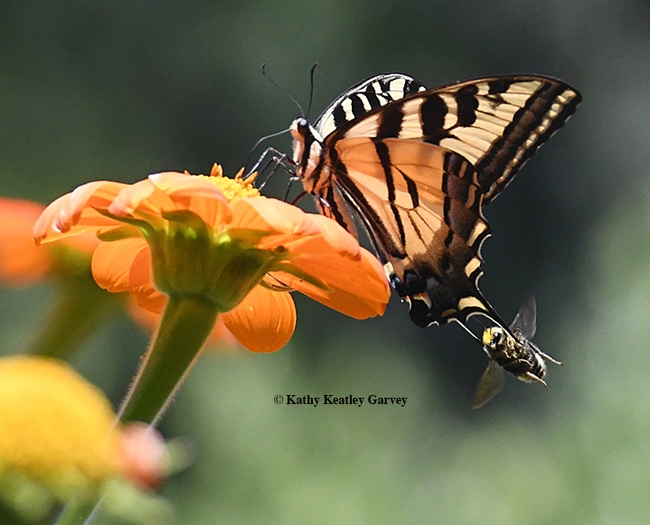
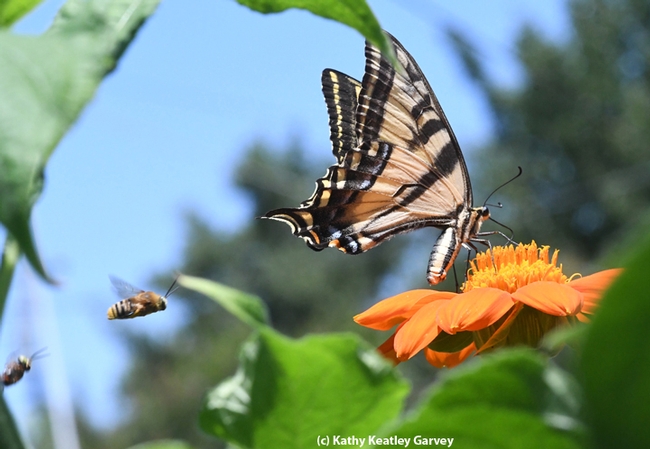
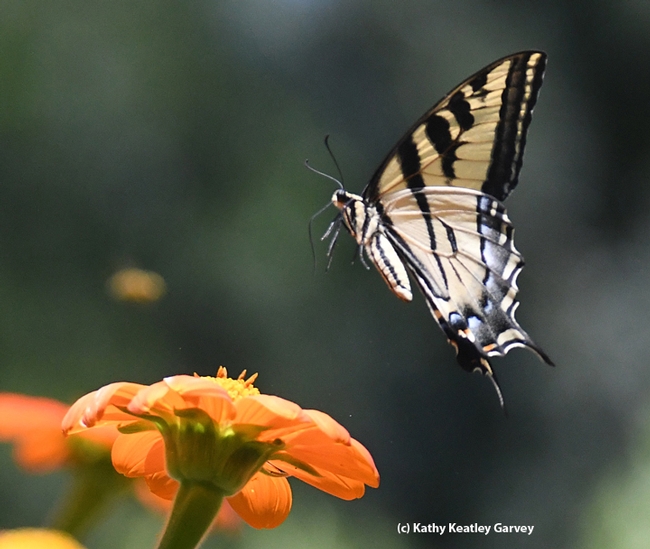
- Author: Kathy Keatley Garvey
Everybody eats in the pollinator garden. Everybody.
The pollinators in our garden in Vacaville, Calif., sip the nectar. They include honey bees, bumble bees, carpenter bees, sweat bees, European wool carder bees, hover flies and assorted butterflies.
The predators eat, too.
It works like this: the pollinators eat the nectar; the predators eat the pollinators. Nature's way.
Today we watched a well-fed praying mantis, Stagmomantis limbata (as identified by Andrew Pfeifer)--look, ma, there's a "mom" in Stagmomantis--lurking beneath the leaf of a showy milkweed, Asclepias speciosa. She was apparently waiting to snag a monarch butterfly, but agreeable to a menu change. So camouflaged was Ms. Mantis that she appeared to be an extension of the leaf. There she clung, motionless but oh-so-alert.
A monarch fluttered by, landing out of reach. Not so for the longhorn bees nectaring on the nearby African blue basil.
A longhorn bee, probably a Melissodes agilis, just wasn't quick enough to escape the Usain Bolt-like swiftness and the grasp of the spiked forelegs.
Ms. Mantis polished off the bee.
After her meal, Ms. Mantis climbed higher on the milkweed, slipping beneath another leaf to look for signs of "meal movement" below.
Well, at least she didn't nail that monarch. Not today.
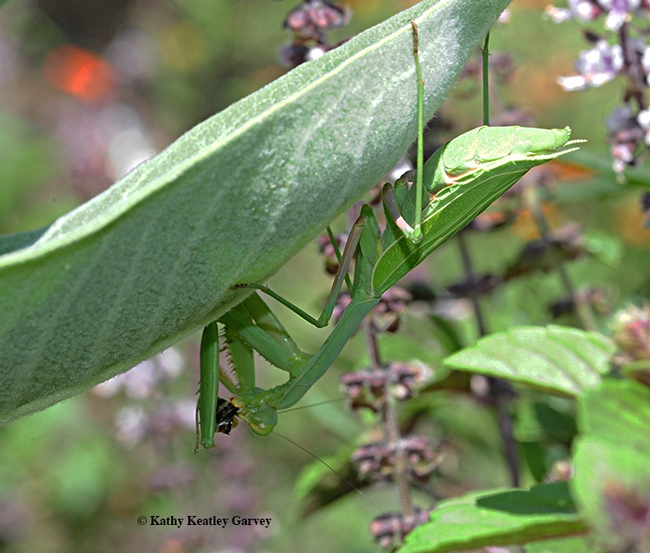
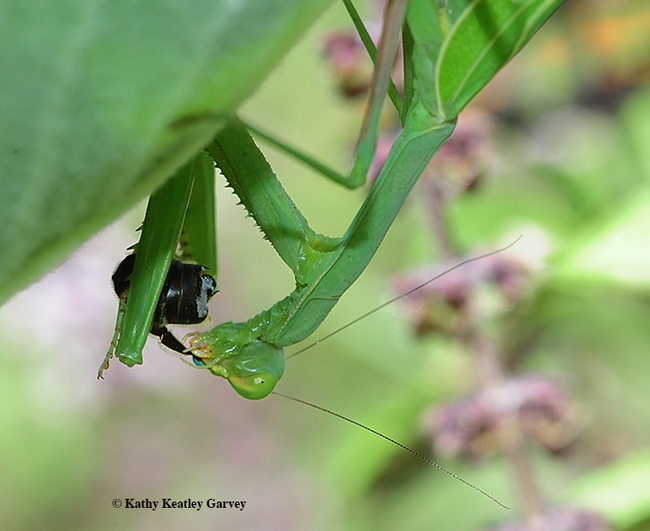
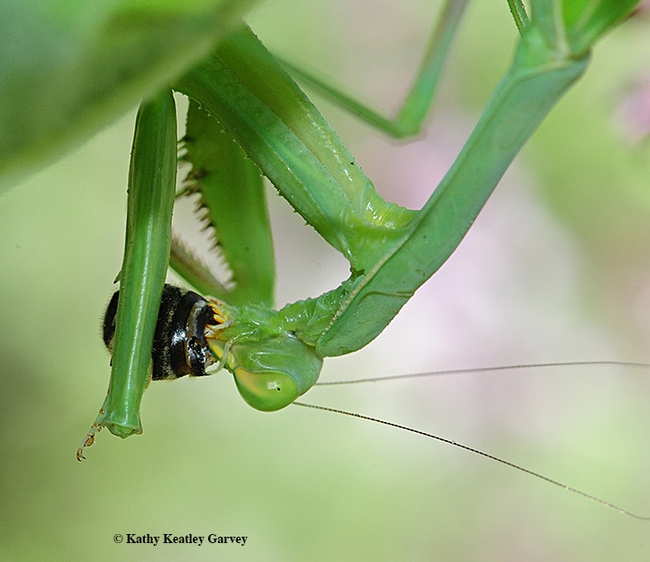
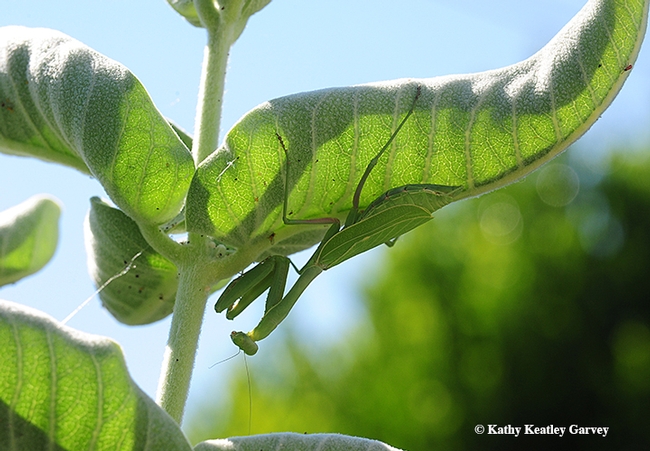
- Author: Kathy Keatley Garvey
It was not a good way to welcome an admiral.
The Red Admiral butterfly, that is.
The Vanessa atalanta fluttered into our pollinator garden on Sunday, July 16 in Vacaville, Calif., and touched down on a Mexican sunflower (Tithonia).
The warmth of the sun, the rich nectar, a soft breeze, and all was well.
For a little while.
Several territorial male long-horned bees spied the stranger and pulled out the welcome mat. In a frenzy, they began dive-bombing the colorful black and red butterfly, trying to chase it away. "Those flowers are for our girls!" they seemed to say. "Leave! Now!"
Everywhere the butterfly went, a squadron of bombers followed. The sailboat-like wings proved a clear target.
One bullet-of-a-bee, probably a Melissodes agilis, slammed into the butterfly's wings, and that was enough.
"This pollinator garden's not big enough for both of us!"

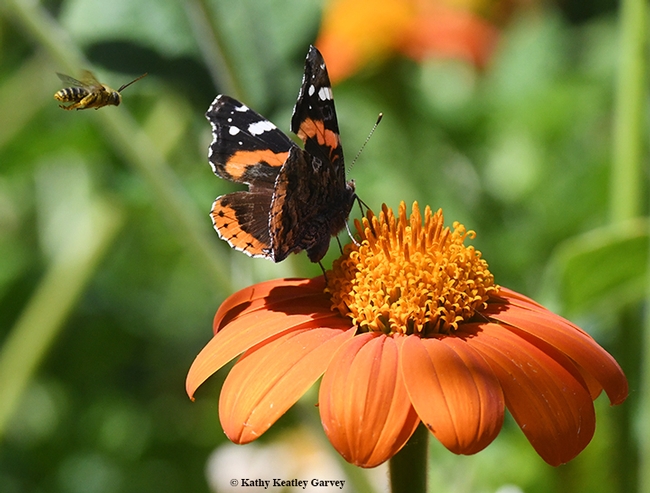

- Author: Kathy Keatley Garvey
So here's this newly eclosed male monarch trying to sip a little nectar from a Mexican sunflower (Tithonia).
A female longhorned bee, probably Melissodes agilis, seeks to claim it. There's no such thing as sharing, especially when nectar is at stake and it's first-come, first-served. However, the monarch is well positioned. There's no room for both a butterfly and a bee. Not at the same time.
Then a male longhorned bee (probably Melissodes agilis) targets the monarch. Shoo, monarch! Outta here! I'm saving that flower for my girl!
If you look closely at the male bee/male monarch photo, you can see the monarch's wings don't seem quite right. They're not. Greg Kareofelas, associate at the Bohart Museum of Entomology, UC Davis, points out that "the wings are deformed; they did not fully expand and dry straight."
As for the longhorned bee, Melissodes agilis is one of more than 1600 species of undomesticated bees that populate California.
To learn more about bees in California, get a copy of the landmark California Bees and Blooms: A Guide for Gardeners and Naturalists (Heyday), the work of bee experts Gordon W. Frankie of UC Berkeley and Robbin W. Thorp of UC Davis, photographer/entomologist Rollin E. Coville, and UC Berkeley botany expert Barbara Ertter.
All have UC Berkeley connections. Thorp, distinguished emeritus professor of entomology at UC Davis, received his doctorate in entomology from UC Berkeley. Coville, who took the amazing, incredibly detailed photos for the book, also received his doctorate in entomology from UC Berkeley.
The book also includes information on 53 bee friendly plants--like Tithonia!--and how to grow them.
Tithonia, a member of the sunflower family Asteraceae, is a favorite of insects. Pull up a chair at a Tithonia patch near you and observe the diversity of foraging insects. Among them: honey bees, bumble bees, sweat bees, longhorned bees, and assorted butterflies, including monarchs, Western tiger swallowtails, Gulf Fritillaries, skippers, California buckeyes, mournful duskywings, painted ladies, and cabbage whites. And oh, some predators, too, including praying mantids and wasps (insects) and crab spiders and orb weavers (spiders).
There's never a dull moment in the Tithonia patch.

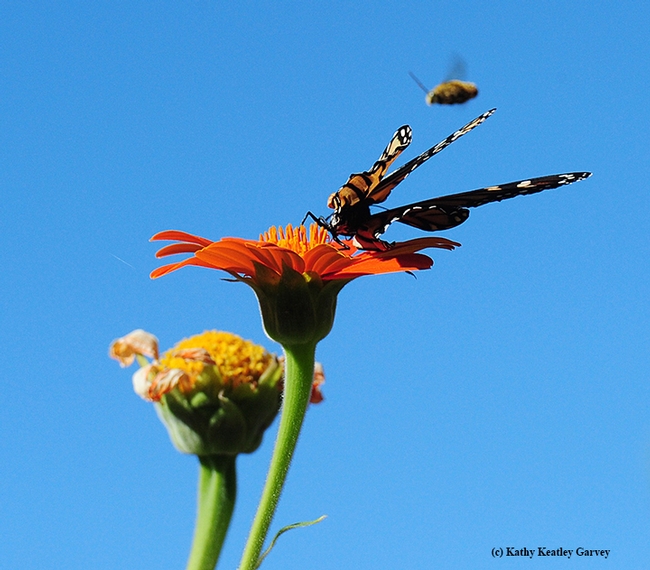
- Author: Kathy Keatley Garvey
Dear Crab Spider,
Please don't eat the pollinators. You may help yourself to a mosquito, a crane fly, a lygus bug, an aphid, and a katydid, not necessarily in that order. And more than one if you like. In fact, how about an all-you-can-eat buffet of luscious lygus bugs? So good! Yes, you may tell all your arachnid friends about the nutritious, high-protein meals available just for the taking. Please do. Just don't eat the pollinators.
Sincerely Yours,
Pollinator Fan
Crab spiders do not listen. They will eat what they want and when they want it. And they will gorge themselves. They are not interested in joining Weight Watchers. They are Wait Watchers.
For the past several months, crab spiders have been lurking on our blanket flower (Gaillardia). Most of the time, they just sit there, waiting patiently for dinner to arrive. Sometimes it's a long wait--longer than it takes for a waiter to return to your table during a rush-hour holiday lunch.
So, Ms. or Mr. Crab Spider--not sure of the gender, but "Predator" will do--dined recently on a sweat bee, a female Halictus tripartitus. We watched Predator lunge at a honey bee (missed!) and pursue at a male long-horned bee, probably Melissodes agilis.
Our cunning little arachnid no doubt nailed a few others--the "waistline" is a dead giveaway.
